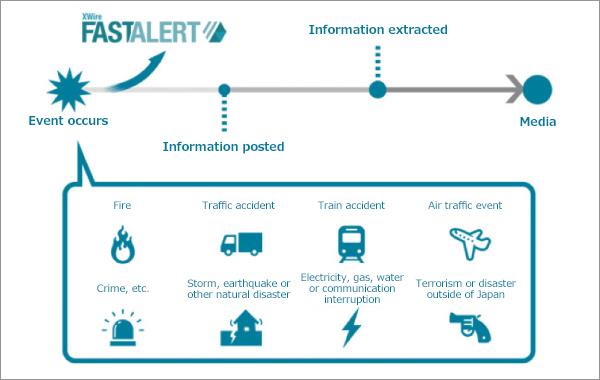
Social media cannot be ignored today as a primary source of information on disasters (earthquakes, floods, accidents, etc.) and emergencies. However, the information contains a lot of unrelated "noise" that makes it difficult to determine the authenticity of the content. FASTALERT, which is introduced in this article, is an emergency information service that uses AI to send only pertinent information in real-time. This article explores the reasons why Japan's most-known media organizations have introduced it and why Panasonic is collaborating with developer JX Press to sell the service far and wide.
The FASTALERT service introduced in this article is intended for use in Japan and utilizes information posted in Japanese on social networking sites.
Summary of this article:
- Social media cannot be ignored today as a primary source of information on disasters (earthquakes, floods, accidents, etc.) and emergencies, but the information contains a lot of unrelated "noise."
- FASTALERT screens emergency information and delivers highly accurate news in real-time.
- Everything from collecting information from social networking sites to editing news stories is automated by AI.
- Going forward, FASTALERT is expected to be introduced not only as a news source by media organizations but also as a risk management tool by public organizations and private businesses.
In an age where anyone and everyone is an information provider, the "accuracy" of information is a major issue
According to a 2017 survey of consumer communication trends released by the Ministry of Internal Affairs and Communications, 60.9% of the people in Japan in 2017 had smartphones. And, over half of these smartphone users used their phones to access social networking sites (SNSs). (Just so that everything is clear, a smartphone is a telephone equipped with a camera, recorder and text typing capabilities.) In other words, current-day Japan can be looked at as having about 100 million cameramen who, if happening upon an accident or caught up in a natural disaster, could potentially provide first-hand information "from the site" via SNSs. In fact, one of the triggers to this use of the smartphone was the Great East Japan Earthquake that struck eight years ago. Alongside the explosive diffusion of the smartphone that followed, SNSs have become an indispensable source of first-hand information during disasters that have occurred since then.
While smartphones ownership rose on the one hand, ownership of cellphones and PHSs (smartphones excluded) fell on the other.
In order to get the word out as quickly as possible, even news organizations in Japan gather first-hand information from SNSs when an event occurs. However, ensuring the reliability of that information is a major issue because it is often fragmented and contains noise unrelated to the content. And, the longer it takes to pick apart and organize the information, the greater the chance there is of delays releasing information when there is not a moment to lose.
FASTALERT, a service provided by news venture JX Press Corp., screens emergency information and delivers highly accurate news in real-time. Restricted to just Japan, this service carefully extracts "when, where and what kind of event occurred" from information posted on SNSs and sends it as a news bulletin to news organizations. The news organizations then sift through the bulletins to compose and release their breaking news.
In just the first six months after the beta version was made available in September 2016, NHK and all major private broadcasting stations joined the big telecom and newspaper companies in subscribing to FASTALERT. Today, FASTALERT is an indispensable tool that Japan's news organizations cannot do without, as it is being used to find images and collect information on events. As a result, TV news is giving increasingly more credit to its viewers for providing content.
FASTALERT detects information on disasters, accidents and other events posted on SNSs and instantly sends reports of what occurred and where.
Technology-ripped AI for automating breaking news
Under a mission banner of "mechanizing news reporting," JX Press aims to solve the news industry's reliance on antiquated methods of acquiring information. This purpose alone puts JX Press in a unique position. Though listed as a communication company, JX Press does not have a single reporter on their payroll and engineers make up two-thirds of their workforce.
Yoshiko Nagami of JX Press explained how FASTALERT came to be: "New organizations have for some time recognized the need to gather information from SNSs, but labor-intensive practices such as having reporters do manual searches that take several minutes per search or enlisting a large number of part-time workers to sift through hordes of information are the norm. We developed FASTALERT to automate this tedious, time-consuming work and pool open resources for reporting that only humans can do, thus enabling a new way to go about work in the process."

Yoshiko Nagami
Public Relations, Operations Administration Dept.
JX Press Corp.
What should be pointed out is that FASTALERT properly composes news stories for delivery as breaking news without requiring human intervention. Moreover, it automatically assigns titles such as "Earthquake Damage in ** City, ** Prefecture" and handles all editing without need for human input. Packed with technology from head to toe, FASTALERT is all about making news reporting more accurate and easier to do.
FASTALERT does the job via a news engine for analyzing news articles and the text and other content that they are composed of and a system for making editing work efficient, which JX Press developed after their founding in 2008. Together with the huge amount of data that was amassed in the process, the service is the lifeblood of the company. Known as "XWire," the hi-tech news engine is the basis of FASTALERT and has been adopted by the Sankei Shimbun Group as the backbone for their flagship "Sankei Plus" news app.

XWire, BaaS news engine that uses AI to automatically edit and send news articles
The ace-up-the-sleeve is AI for analyzing text, still images and movies. It holds the key to efficiently sorting out noise from still images and movies contained in information from the site of a disaster or accident, as well as ensuring a high level of natural language processing. Ms. Nagami described how it works: "Training data is set first and incoming data is matched to it. For example, with an image of a fire, an analysis is done to determine whether the fire was caused by a real fire or whether the image is of meat on the grill at a barbeque restaurant. A wide variety of patterns are archived and used for comparisons."

Screenshot of a FASTALERT window. Language and images posted on SNSs are analyzed and only information believed to be pertinent is instantly collected and released.
The news organizations that introduced the service have highly praised FASTALERT for its speed and comprehensiveness. In just these few years, it has been used for distributing news bulletins to media organizations across Japan on too many occasions to count, such as the train bridge on the Kyudai Line that was washed away because heavy rainfall in Kyushu, the Eastern Iburi Earthquake and the fires that ravaged Itoigawa City. As for its being comprehensive, there were cases where news organizations could not have possibly covered stories by conventional reporting methods like the child that was born on a train on JR's Joban Line and the herd of pigs that escaped from a truck on the Hanshin Expressway.
In any case, the more quickly information about fires, events and so forth can be detected, the more quickly action can be taken and secondary damage contained. As Ms. Nagami pointed out, "News outlets can dispatch reporting crews and helicopters to sites based on information obtained from FASTALERT, so it is an indispensable tool at the forefront of news reporting." This can be considered a good example of technology being effectively used to make up for the shortfalls of limited human resources.
A helpful tool for enhancing safety and security in disaster-prone Japan
News organizations are not the only ones needing fast accurate information on emergencies. FASTALERT is also drawing strong interest from public organizations, social infrastructure administrators and even private businesses who are seeking better and more effective approaches to disaster prevention and risk management. In disaster-prone Japan, FASTALERT might be the help society is looking for.
Catching sight of this potential, Panasonic System Solutions Japan (hereinafter "Panasonic") teamed up with JX Press as a distributor. In the B2B market, they were already supplying safety and security solutions like wireless systems to public organizations and social infrastructure administrators all across Japan, so, when Panasonic got involved, they were well positioned to create synergies by combining FASTALERT into packagable solutions.
Toshihiro Toh from Panasonic explained, "Panasonic is at an advantage because we are well versed in the operations of the public and social infrastructure sectors. In the public sector, you have governments, police, fire departments, administrative offices and so forth, while in the social infrastructure sector, you have communications, traffic, energy, broadcasting and other service providers. We're confident that we can offer both of these sectors high value-added solutions by bundling in FASTALERT."

Toshihiro Toh
Solution Team 1, Security Systems Dept., System Products Center
Panasonic System Solutions Japan Co., Ltd.
Panasonic's encounter with JX Press was at a tradeshow related to disasters. Seeing for himself how breaking news was produced on the system screen practically in real-time, Mr. Toh recounted, "The speed and accuracy were very compatible with our solutions. FASTALERT provides valuable information for making decisions and launching investigations in a disaster." Persons in charge of crisis management at public organizations have been wanting to use SNSs, but because of the risk it poses to residents, information sourced from SNSs cannot be released to the public unless it can be trusted.
Mr. Toh added, "Their biggest concern was how reliable it was. For that reason, JX Press and Panasonic conducted a month-long trial with it. Many of our customers who tried it said it was 'simply wonderful' and we continue to receive lots of inquiries not only from public organizations but private businesses as well."
While all of that was going on, Panasonic was feeling out customers for new demands and feeding them back to JX Press. Adding the ideas from places other than news organizations would only improve FASTALERT more. Mr. Toh highlighted that "What makes JX Press so good is the speed with which they work. In the past, we had them quickly develop features on more than one occasion." In response to that, Ms. Nagami noted, "JX Press is very open to trying new development languages and technologies. Asking more of us only motivates our engineers more." This collaborative relationship has had and continues to have a visible synergistic effect.
Sharing his hopes for the future, Mr. Toh commented, "I'd like to see AI analyses of various information sources other than SNSs. By fusing FASTALERT into our solutions, I think we can grow it into an indispensable service during disasters in Japan." JX Press feels similar, as Ms. Nagami explained, "By gathering a wide range of information from the general public, we are aiming at tapping into 'collective intelligence.' We want to use that to create a future where damage and losses across society or an entire region are minimized."
Example application
The Japanese government is exploring the potential use of FASTALERT for its disaster response efforts. It was reportedly used in the Eastern Iburi Earthquake that rocked Hokkaido in September 2018. So, how do they envision using it to gather disaster information from SNSs? Below are introduced some comments from the Cabinet Office.
- The word is that FASTALERT was experimentally used in the Eastern Iburi Earthquake. What led to that and what was hoped to come from that?
Cabinet Office: At the Cabinet Office, we are exploring ways for disaster response organizations to use ICT to swiftly and systematically grasp the situation in a disaster. We are talking about a "disaster information hub." As a part of this effort, Information Support Teams (ISUT) tested FASTALERT in 2018 to collect and map out damage information. SNSs were considered one of many sources of information that could be used.
- What was your impression after using FASTALERT?
Cabinet Office: SNSs contain massive amounts of information of various nature and kind, which makes typed-in keyword searches unrealistic. For that reason, AI-driven analyses seem more effective.
In the Eastern Iburi Earthquake, when checking FASTALERT, the Hokkaido government discovered reports of liquefaction in Kiyota-ku, Sapporo City with photographs, but, soon after that, there were postings of liquefaction gradually spreading to surrounding areas. Without actually visiting the areas, this information was sufficient enough to surmise that the situation was possibly worsening.
Another advantage would be that, if retail stores post information on sales, we can infer the situation regarding the distribution of goods.
Though it is hard to corroborate the information from SNSs, FASTALERT is a viable means for collecting information from the perspective of interpreting a situation and plotting strategies to deal with it when information is limited. FASTALERT is an easy-to-use and functionally adept service that narrows down information to the core essentials, attaches image information and does much, much more.
- What do you see lying ahead regarding the use of information from SNSs?
Cabinet Office: I sensed some difficulty in sharing SNS-sourced information with other organizations. Though, in this case, our ISUT used it to grasp the situation, there are problems in sharing it with other organizations, such as, for example, since the information is not corroborated, to what extent should the information be shared and how can it be effectively shared with a wide range of people.
Moreover, in using this information, it is critical that the concerned persons understand that the information sourced from SNSs is not corroborated.
Keigo Matsuda
Deputy Director to Director General for Disaster Management and Director of Disaster Management Planning
Cabinet Office
- Reproduced from the website "Mirai-kotohajime", by courtesy of Nikkei Business Publications, Inc.
# # #
- Disclaimer:
- We would like to note that Panasonic Newsroom is not a place to address personal Customer Service issues. Even though this is not the forum, Panasonic is always eager to resolve your concerns. Our local customer services contacts can be found at Global Support or you can see our list of Social Media Accounts to find the right channel for your queries and concerns.
Related News
- Developed with Teamwork, Cleaning Robots Busily Vacuum the Floors During the Wee Hours at Tokyo Midtown Hibiya (Apr 22, 2019)
- The First-Ever "Head Car Scuffing Machine" for the Shinkansen Bullet Train: Dexterous Force Control Replicated by "Japan's Engineering Prowess" (Apr 03, 2019)
- What Is the AI Supporting the First Step? The Reasons for the Birth of the Passenger Boarding Bridge Automated Docking System (Part 2 of 2) (Mar 15, 2019)
- What Is the AI Supporting the First Step? The Reasons for the Birth of the Passenger Boarding Bridge Automated Docking System (Part 1 of 2) (Mar 15, 2019)









